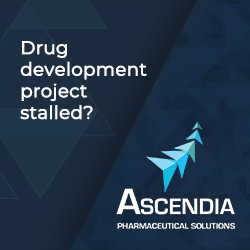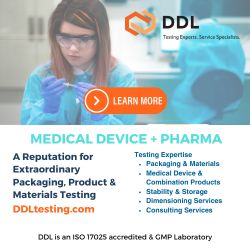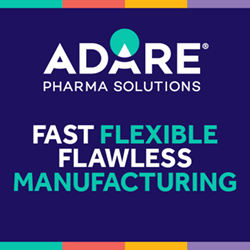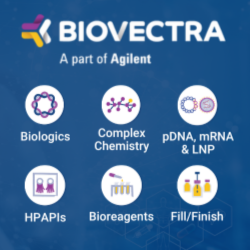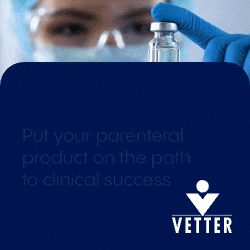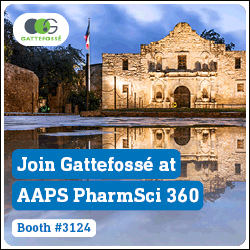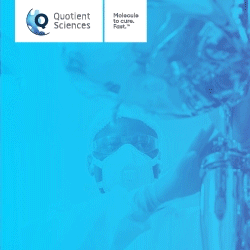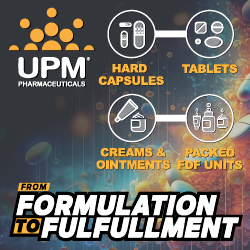Drug Delivery
Azalea Therapeutics Presents New Preclinical Data Demonstrating Robust In Vivo Generation of TRAC-CAR T Cells Using Enveloped Delivery Vehicles
Azalea Therapeutics, Inc. recently announced new preclinical data demonstrating robust in vivo generation of functional TRAC-CAR T cells using its proprietary Enveloped Delivery Vehicle (EDV) technology.…
Acumen Pharmaceuticals Announces First Participant Dosed in Phase 2 Open-Label Extension Study of Sabirnetug in People With Early Alzheimer’s Disease
Acumen Pharmaceuticals, Inc. recently announced the first participant has been dosed in the open-label extension (OLE) portion of its Phase 2 ALTITUDE-AD clinical trial evaluating…
WHITE PAPER - Advancements in Intradermal Delivery: From Historic Techniques to Modern Innovations
This white paper explores the evolution of intradermal delivery methods, comparing historic methods of delivery such as the Mantoux technique with modern innovations such as the Terumo Immucise™ Intradermal Injection System.
4DMT Announces Exclusive License Agreement With Otsuka Pharmaceutical for Development & Commercialization of 4D-150 in Asia-Pacific
4D Molecular Therapeutics recently announced a strategic partnership with Otsuka Pharmaceutical Co., Ltd. (Otsuka) to develop and commercialize 4D-150 for the treatment of wet age-related…
NodThera Announces First Patients Dosed in RESOLVE-2 Clinical Trial Evaluating Oral NT-0796 in Combination With a GLP-1 Receptor Agonist
NodThera, a clinical-stage biotech pioneering a paradigm shift in the treatment of chronic inflammatory diseases through NLRP3 inhibition, today announced that the first patients have…
Owen Mumford Launches EcoSafe Safety Syringe Platform - Smarter for Budgets & Kinder to the Planet
The EcoSafe 1ml safety syringe (previously branded UniSafe) is compatible with the new reusable EcoSafe autoinjector – creating the first and only fully integrated safety…
MannKind Announces FDA Accepts for Review its sBLA for Inhaled Insulin in Children & Adolescents
MannKind Corporation recently announced the US FDA has accepted the supplemental biologics license application (sBLA) seeking approval for Afrezza (insulin human) Inhalation Powder in children…
Shape Therapeutics Shares Breakthrough Preclinical Data for Non-Invasive Treatment of Parkinson’s Disease Using a Brain Targeted AAV Gene Therapy
Shape Therapeutics recently announced it presented new preclinical data highlighting the therapeutic potential of its lead product (SHP-201), a disease-modifying gene therapy for the treatment…
Ligand Partner SQ Innovation Receives FDA Approval for Lasix ONYU, an At-Home Treatment for Edema in Heart Failure Patients
Ligand Pharmaceuticals Incorporated recently announced that its partner SQ Innovation Inc. has received approval from the US FDA for Lasix ONYU (furosemide injection), a novel…
Gelteq Announces New Product Development Agreement With Melbourne Health for Novel Bowel Polyp Growth Reduction Compound
Gelteq Limited recently announced it has entered into a Product Development and Profit Share Agreement with Melbourne Health, operator of The Royal Melbourne Hospital and…
Nutriband Files Provisional Patent Application for Enhanced Transdermal Abuse Deterrent Technology
Nutriband Inc. recently announced that it has filed a provisional patent application with the US Patent and Trademark Office (USPTO) to further strengthen Nutriband’s intellectual…
SPECIAL FEATURE - Excipients: Innovation in a Shifting Pharma Landscape
Cindy H. Dubin speaks with several companies and highlights this innovation and reveals how excipient suppliers are doing their part to ensure a reliable, resilient, and compliance-driven supply chain.
FORMULATION FORUM - Orally Disintegrating Tablets
Shaukat Ali, PhD, and Jim Huang, PhD, say as more NCEs are being discovered, the industry is weighing all options for evaluating those molecules in different dosages to improve solubility and oral bioavailability. With requirement for taste-masking of bitter drugs with commercially available ODT excipients, it poses additional challenges for improving taste-masking and performance of molecules for the intended usages.
LIPID FORMULATION DEVELOPMENT - Why Softgels Are the Technology of Choice
Dipanwita De, PhD, and Kaspar van den Dries say solubility and bioavailability in OSD formulations remain major challenges within the early stages of drug development. While technological innovations have allowed the pharmaceutical industry to make progress in solving this hurdle, choosing formulations that help achieve desirable solubility and bioavailability can help speed up development of the most promising molecules.
EXCIPIENT TECHNOLOGY - Driving Oral Drug Delivery Innovation With Safe, Reliable Lipid Excipients
Nick DiFranco, MEM, says amidst the uncertainty of novel ingredients and formulation techniques, lipid excipients provide a safe, proven platform for enhancing in vivo formulation performance, enabling innovation without sacrificing scalability or regulatory confidence.
EXECUTIVE INTERVIEW - Intensity Therapeutics: Providing Cancer Patients With Treatments That Work
Lew Bender, Founder and CEO of Intensity Therapeutics, discusses the company’s science, clinical program, the drug development process, and more.
RheumaGen & SiVEC Biotechnologies Announce CGT Partnership & In Vivo Program to Cure Common Autoimmune Diseases
RheumaGen, Inc. and SiVEC Biotechnologies, Inc. recently announced a licensing and joint development agreement for a breakthrough class of gene-editing therapies designed to cure autoimmune…
Terumo Announces Completion of Acquisition of WuXi Biologics Drug Product Plant in Leverkusen, Germany
Terumo Corporation recently announced the successful completion of its acquisition of a Drug Product Plant and associated Quality Control Laboratory operations from WuXi Biologics in Leverkusen,…
NanoPhoria Bioscience Secures Funding to Advance Breakthrough Heart Failure Therapy & Expand Portfolio for Novel Nano-in-Micro Delivery Platform
NanoPhoria Bioscience recently announced the successful first close of its €83.5 million Series A financing round. The round was led by XGEN Venture, Sofinnova Partners,…
Oculis Accelerates Privosegtor Into Registrational Trials in Acute Optic Neuritis, Pioneering the Path for a Potential First-in-Class Neuroprotective Therapy
Oculis Holding AG recently announced the advancement of Privosegtor into a registrational program for neuro-ophthalmology indications following a positive meeting with the US FDA. Privosegtor…
What are Drug Delivery Systems?
Drug delivery systems are engineered technologies for the targeted delivery and/or controlled release of therapeutic agents. The practice of drug delivery has changed significantly in the past few decades and even greater changes are anticipated in the near future. Drug delivery includes but is not limited to oral delivery, gene/cell delivery, topical/transdermal delivery, inhalation deliver, parenteral delivery, respiratory delivery, capsules, particle design technology, buccal delivery, etc.
The Evolution of Drug Delivery Systems
Drug delivery systems have greatly evolved over the past 6 decades. In the past 12 years specifically, there have been huge advancements in drug delivery technology. For instance, advanced medication delivery systems, such as transdermal patches, are able to deliver a drug more selectively to a specific site, which frequently leads to easier, more accurate, and less dosing overall. Devices such as these can also lead to a drug absorption that is more consistent with the site and mechanism of action. There are other drug delivery systems used in both medical and homecare settings that were developed because of various patient needs and researchers continue to develop new methods.
Drug Delivery System Market Size
The pharmaceutical drug delivery market size is studied on the basis of route of administration, application, and region to provide a detailed assessment of the market. On the basis of route of administration, it is segmented into oral delivery, pulmonary delivery, injectable delivery, nasal delivery, ocular delivery, topical delivery, and others.
The estimated global market size of drug delivery products was $1.4 trillion in 2020. Unfortunately, 40% of marketed drugs and 90% of pipeline drugs (mostly small molecules) are poorly soluble in water, which makes parenteral, topical, and oral delivery difficult or impossible. In relation, poor solubility often leads to low drug efficacy. Add in the fact that many other hurdles exist in the form of drug loading, stability, controlled release, toxicity, and absorption – it’s not hard to understand the difficulties in bringing new drug products to market. Additionally, biopharmaceuticals (proteins, peptides, nucleic acids, etc) and combination drug products possess many of these same problematic obstacles that affect efficacy. These challenges, coupled with the complexity and diversity of new pharmaceuticals, have fueled the development of a novel drug delivery platforms that overcome a great many bioavailability and delivery obstacles. By leveraging these platforms, pharmaceutical and biopharmaceutical companies can improve dosing accuracy, efficacy, and reproducibility in their drug discovery and drug delivery research.
Drug Delivery System Demand
The demand for pharmaceutical products worldwide is only going to increase in the coming years, as old and emerging diseases continue to threaten the well-being of people globally. Drug discovery efforts are expected to intensify, generating a large variety of active compounds with vastly different structures and properties. However, it is well known that despite tremendous output of the drug discovery process, the success rate of a candidate compound becoming an approved drug product is extremely low. The majority of candidate compounds are discarded due to various hurdles in formulation and preclinical testing (such as issues with solubility, stability, manufacturing, storage, and bioavailability) before even entering into clinical studies. Therefore, advances in formulation and drug delivery, especially the development of new and versatile biomaterial platforms as effective excipients, may salvage many “difficult,” otherwise triaged, drug compounds, and significantly enhance their chance of becoming viable products. Furthermore, breakthroughs in biomaterial platform technologies will also facilitate life cycle management of existing APIs through reformulation, repurposing of existing APIs for new indications, and development of combination products consisting of multiple APIs.







